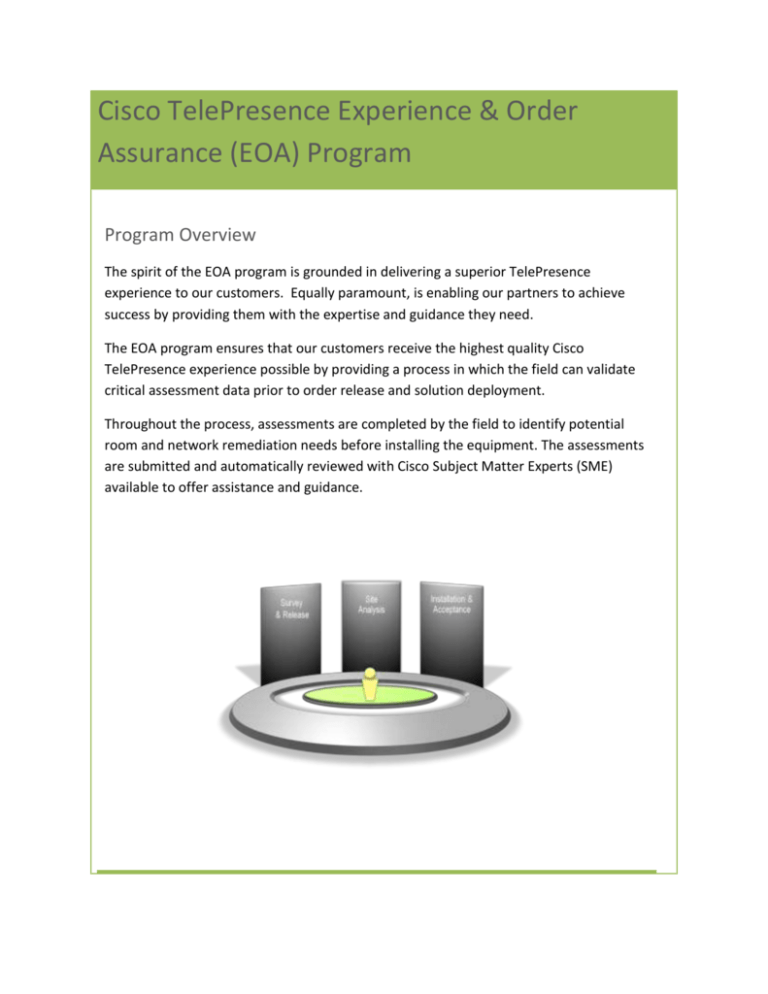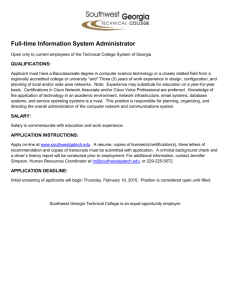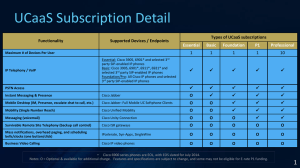
Cisco TelePresence Experience & Order
Assurance (EOA) Program
Program Overview
The spirit of the EOA program is grounded in delivering a superior TelePresence
experience to our customers. Equally paramount, is enabling our partners to achieve
success by providing them with the expertise and guidance they need.
The EOA program ensures that our customers receive the highest quality Cisco
TelePresence experience possible by providing a process in which the field can validate
critical assessment data prior to order release and solution deployment.
Throughout the process, assessments are completed by the field to identify potential
room and network remediation needs before installing the equipment. The assessments
are submitted and automatically reviewed with Cisco Subject Matter Experts (SME)
available to offer assistance and guidance.
Process Overview
There are 3 primary steps involved in the process that will help our partners deliver an
exceptional TelePresence experience. The 3 steps are:
SURVEY & RELEASE
SITE ANALYSIS
INSTALLATION & ACCEPTANCE
Again, the goal is to simplify the process, making it easier to execute, with added
assurance for customer satisfaction, while at the same time accelerate the Compliance
Hold release on customer orders.
SURVEY & RELEASE
The overall goal of the survey and release step is to provide a way for the partner to
evaluate a customer’s existing room and network infrastructure without anything more
than then collecting the information through conversations and interviews.
Furthermore, even if the customer is building a new room(s) and/or an overlay network,
it is still very important to use this step to ensure that all the necessary areas are
evaluated and considered. Additionally, this step provides a mechanism by which
product hold can be released.
Once the surveys are submitted in the EOA Web Tool, an immediate response is given.
Depending on the results, the equipment can be released from Compliance Hold, or
further review between the TSBU Engineering team and the partner will be required to
help resolve any major issues.
There are three or four forms required in this step depending on the Product type being
deployed:
*Prequalification
Network Path Assessment Survey
Room Readiness Assessment Survey
Product Hold Release Request (PHR)
Prequalification
The prequalification form is a high level questionnaire, which could be referred to as a
‘survey’. While it does include some questions around network and application, it is far
more focused on the room environment. History shows that the prequalification is a
proven method of quickly highlighting areas of needed remediation for the customer,
giving them more time to respond, plan and begin room and/or network remediation. In
fact, many partners have used the prequalification as a way to help the customer select
a room that will support TelePresence with the least amount of remediation.
Network Path Assessment Survey
The Network Path Assessment Survey provides adequate assurance that the partner has
reviewed major areas of the network and application environment and communicated
results to the customer for review and possible remediation. It is required for all
TelePresence endpoint types, including the management components. The major areas
covered in the NPA Survey include:
TelePresence Versions Compatibility
Call Management
Call Scheduling
Multipoint
Interoperability
Inter-company Exchange
Auto-Collaboration
Network Design
QoS and Security
Hardware/Software Infrastructure
Room Readiness Assessment Survey
The Room Readiness Assessment Survey provides adequate assurance that the partner
has reviewed major areas of the room and environmental characteristics and
communicated results to the customer for review and possible remediation. It is
required for all Triple Screen Systems. The major areas covered in the RAA Survey
include:
Remediation Status
Environment Overview
Power
Network Data Ports
HVAC
Visual Obstructions
Illumination (Fixture Type)
Drawings
Floor Plan
Reflected Ceiling Plan
Pictures
Product Hold Release Request (PHR)
Another very important piece of the first step in the process is the actual mechanism to
request the release of product hold, or Compliance Hold. Because Cisco does not dictate
how the partner places the customer order, many complexities can arise which force the
EOA Team to manage orders very precisely. This then makes it imperative to put the
ownership in the hands of the partner to initiate the specific request for Compliance
Hold, so that all precautions are made to not inadvertently ship equipment that the
customer is not prepared to receive, let alone deploy.
Process Requirements
Again, using the product family categories will make understanding EOA process
requirements easier.
Single Screen Systems Process (CTS-500, CTS-1000, CTS-1300-65)
Because the Single Screen Systems do not typically require the same level of Room
Remediation to the degree as the Triple Screen Systems, the EOA program only requires
that the Network Path Assessment Survey and Network Path Assessment Site Analysis be
completed for single screen systems.
This is not to say that Single Screen Systems may not benefit from a Room Readiness
Assessment, and that in some cases room remediation would be favorable to increase
the overall experience.
This process is depicted in the below diagram.
TelePresence Component Process
The TelePresence Components included in the EOA Program are the CTS-Manager and
the CTS-CTMS (Multipoint). The process to release the components from Compliance
Hold has been simplified with the new NPA. Both require the NPA Survey to be
completed and the subsequent release request. However, only the multipoint switch
requires the follow-on NPA Site Analysis to also be completed.
Triple Screen System Process
For the Triple Screen Systems, however, the process is a cross-over between the original
serial process and the new parallel process. These larger and more complex systems
require that Room Readiness also be evaluated prior to deployment. The Room
Readiness Assessment (RRA) will be redesigned into a two part process, similar to the
new NPA, within the coming months. Until that time we will continue to leverage the
existing serial process for the Room Readiness requirements.
The diagram below depicts what is required by the EOA process before the order ships.
The Prequal, NPA survey, and the full RRA are required before Compliance Hold can be
released. Notice that the parallel process is in place for the Network Path Assessment as
explained previously.
SITE ANALYSIS
The purpose of this step is to guarantee that the room(s) and network paths are within
the required specifications for Cisco TelePresence. Using measurements tools, raw data
is extrapolated from the room and network environment. It is important to note that as
the EOA process transitions fully to this new model, the release of the equipment is
occurring ahead of the final assessment step. This means that the ownership of ensuring
it is performed and evaluated prior to installation and deployment is put on the partner.
There are 2 assessments as part of this step:
Room Readiness Assessment Site Analysis
Network Path Assessment Site Analysis
Room Readiness Assessment Site Analysis
The Room Readiness Assessment is a comprehensive test that includes many room
environment variables. A special RRA Kit is used to gather this information and contains
things like light and sound metering tools. Each partner is required to procure an RRA Kit
either from the dealer that Cisco recommends, or can purchase similar devices to
capture the needed data. The following lists the general areas that are covered under
the RRA.
Environment Detail
STC
NRC
IIC
Ambient Noise Floor
Reverberation
Illumination Details
Illumination Measurements
Network Path Assessment Site Analysis
As mentioned earlier, the Network Path Assessment Site Analysis collects path statistics
such as latency, jitter, and loss and can only be captured once circuits and/or paths are
fully provisioned and functional. It can be completed in parallel with the shipment in
order to meet project timelines, customer expectations and accelerate the overall
process. This is the full list of the major areas currently covered in the NPA site analysis.
Link Utilization
Device Utilization
BW, Latency, Jitter, Loss
INSTALLATION & ACCEPTANCE
This final step in the process can best be understood as the installation and final
validation. Needless to say, installation is self explanatory. Other than mentioning that
only a skilled technician should be performing the installation, it is important to note
that installation should not occur until the room and network remediation is complete.
Once the units are installed, any further remediation work may become much more
difficult and costly to implement.
So what does Installation & Acceptance mean?
It is best explained through use of the categories of the product family. It is expected
that the partner will ensure that all room and network remediation has been completed
prior to installation, or at the very least prior to the time the customer has accepted the
solution and began to use it.
The EOA process can be leveraged to determine an exact measurement that needs to be
reached before being considered ready for production deployment. Let’s examine this.
Single Screen Systems
With Single Screen Systems, the EOA Process can be leverage so that Production
Deployment should not occur until that particular ‘site’ has a Network Path Assessment
Survey and Site Analysis with a GREEN condition. This means that all aspects of the
Network Readiness have been addressed.
Triple Screen Systems
With Triple Screen Systems, Cisco goes one step further. While it is left to the partner to
ensure that all room and network remediation is complete, the Cisco TSBU engineering
group requires an additional assessment be performed, thereby certifying the room for
production. The validation is known as Cisco TelePresence Experience Validation, or
CTX. The CTX historically was performed only by the Cisco engineering team and was
performed by a Cisco TSBU engineer onsite. It was done using the same RRA Kit that a
partner would use during the RRA Site Analysis step, but also went further to perform a
quasi Customer Acceptance Test.
However, with the most active and proven partners, a new process has been
implemented to accelerate the validation process. This new process is called Post
Installation Assessment, or PIA. This process enables the partner to perform the
assessment immediately following the installation and deployment of TelePresence.
Using the RRA Kit, performing the same customer acceptance tests, and submitting the
information and additional pictures to Cisco engineering, a ‘remote CTX’ can be
delivered. This is the preferred method for partners and Cisco alike, as it puts more
ownership on the partner and accelerates the time to signoff with the customer.
Three Steps to Success
To understand the steps to success, it is essential to answer the most basic questions.
The table below outlines the “What, Why, Who, When, Where, and How” for each step
in the EOA Program.
Survey & Release
What
The first step in the EOA process.
It is designed to assist the field in evaluating a customer’s Room and
Network Readiness at a high level and provide the mechanism to request
Compliance Hold release. Specifically, the online forms that need to be
completed in this step include:
Prequalification: A series of high-level questions generally related to room
environment. Once submitted, an immediate evaluation and response is
generated indicating areas and level of remediation needed.
Network Path Assessment Survey: A range of broad and more specific
questions related to network, application and infrastructure design and
implementation. It covers Network Readiness holistically.
Room Readiness Assessment Survey: A range of broad and more specific
questions related to room & environmental characteristics. It covers Room
Readiness holistically.
Product Hold Release Request (PHR): A short form used to initiate a formal
request to release Compliance Hold. It captures the Sales Order Number,
Line Item, Ship Set Number, etc. and automates the release workflow
between the partner, EOA Team, and Cisco manufacturing.
Why
This step is the initial assurance that appropriate discussions and predeployment reviews have occurred between the partner and the end
customer.
Additionally, controlling the release of equipment assists the partners in
managing the delivery at the end customer site. Because all TelePresence
orders are owned by partners, it is very important that they control the
release and management of them.
Who
The people involved range from Cisco Account Teams, Partners, and Cisco
AS.
Prequalification: Cisco Account Team, Partner, or Cisco AS.
Network Path Assessment Survey: Partner or Cisco AS
Room Readiness Assessment Survey: Partner or Cisco AS
Product Hold Release Request: Partner or Cisco AS
When
Some elements can be completed prior to an order being placed, while
other elements occur after the order is booked.
Prequalification: Before or after an order is booked
Network Path Assessment Survey: Before or after an order is booked
Room Readiness Assessment Survey: Before or after an order is booked
Product Hold Release Request: After an order is booked
Where Collecting the information required to complete the forms can be done via
onsite or remote meeting with customer.
Completing the submission of the data for EOA Process is done via the EOA
Web Tool online. https://tools.cisco.com/tsbu/oa/index.html
How
First, data is collected by communicating with the end customer.
Next, that data is transferred into the EOA Web Tool. This simple online
tool provides an immediate response which can then be shared with the
customer.
The Product Hold Release request is completed directly on the EOA Web
Tool. The EOA team reviews and approvals are automatically sent to Cisco
manufacturing.
Site Analysis
What
The second step in the EOA Process. The 2 types are:
Room Readiness Assessment Site Analysis: An in-depth series of tests
performed using an RRA Kit which includes an acoustics and light meter.
Network Path Assessment Site Analysis: An in-depth ‘path’ test performed
using one of several tools available to capture latency, jitter, and packet
loss.
Why
To ensure room and network remediation needs, and/or confirmation that
remediation or build-to-spec rooms and networks have been done
correctly.
Who
Room Readiness Assessment Site Analysis: Partner or Cisco AS
Network Path Assessment Site Analysis: Partner or Cisco AS.
When
Room Readiness Assessment Site Analysis: Before and/or after room
remediation or build-to-spec has occurred, and before endpoint
installation.
The Network Path Assessment Site Analysis: After circuits are installed and
before deployment.
Where
Room Readiness Assessment Site Analysis: Onsite in proposed endpoint
installation location.
Network Path Assessment Site Analysis: Onsite, central location, or one
side of a path.
How
Room Readiness Assessment Site Analysis: Data capture is done using the
RRA Tool Kit. Results are uploaded into the EOA Web Tool.
Network Path Assessment Site Analysis: Data capture is done by using one
of the following tools. IPSLA, VSAA, CTS Codec, or other. Results are
transferred into the EOA Web tool.
Installation & Acceptance
What
The final step in the EOA Process.
Single Screen Systems require a ‘GREEN’ status on the NPA Survey and NPA
Site Analysis, before meeting the guideline of a product ready ‘room’.
Triple Screen Systems require a Validation status of ‘PASS’ before being
considered production ready. They are validated for their acoustics,
lighting, continuity, and network design and system performance.
Why
This ensures customer satisfaction and eliminates potential issues after the
end customer is using the system. Logistically, it is far easier to address
any issues before the customer begins using them.
Who
Installation: Partners or Cisco AS.
Validation: A combination of the partner or Cisco AS, and Cisco
engineering.
When
Installation: After the rooms and network are in optimal condition.
Validation – Onsite: 1-2 weeks after installation.
Validation – Remote: Within 24 hrs.
Where
Installation: Occurs on customer premises
Validation: Onsite or remote.
How
Installation occurs by skilled technicians following the specific Assembly
Guides provided by Cisco.
Validation is performed using the RRA Kit and a series of ‘user acceptance’
test scenarios. Cisco Engineer will transfer data to EOA Web tool and
produce a response that is generated and emailed to partner for delivery
to the customer. If done by remotely, partner sends a collection of
pictures and test results to Cisco Engineer for validation.
Related Support Information
EOA Web Page https://tools.cisco.com/tsbu/oa/index.html
Partner Resource Central http://www.ciscoet.com/solutionfrontpage.asp?sid=7
Cisco Technical Support (TAC) Cisco TAC Website
Customer Service Cisco Customer Service Website
Contacts | Feedback | Help | Site Map
© 1992-2008 Cisco Systems, Inc. All rights reserved.
Terms & Conditions | Privacy Statement | Cookie Policy | Trademarks of Cisco Systems, Inc.








